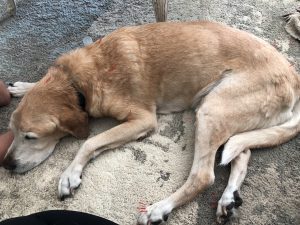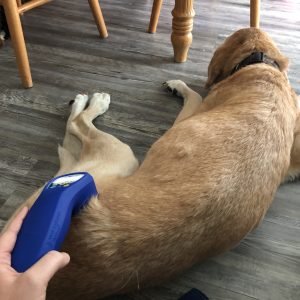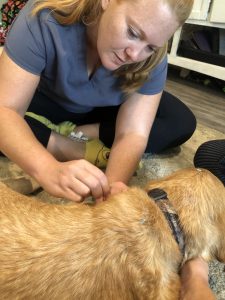Written by a CuraCore Veterinary Medical Acupuncture course graduate. Signed release obtained from client/author. 10S2019003
Abstact: A thirteen-year-old Labrador retriever presented with worsening hindlimb and forelimb weakness that resulted in decreased activity and appetite. Ten-minute dry acupuncture sessions were performed along with cold laser therapy over the course of four weeks. The results included increased activity levels as well as appetite.
History and Presentation: Coach is a thirteen-year-old male neutered yellow Labrador retriever who was purchased as a puppy from a private breeder. Annual exams and vaccines have been kept up to date as well as flea and heartworm preventative medication. The owners note Coach has always been a very active and healthy dog with no history of illness who would play fetch for hours if allowed. Coach is currently not on any medications but has been on gabapentin and carprofen in the past for episodes of previously diagnosed arthritic flare ups. Senior bloodwork and radiographs have not been performed due to the difficulty of getting Coach into the veterinary clinic. He currently lives with three young children and a one-year old cocker spaniel who the family purchased as a puppy. The owners stated that Coach has continued to show signs of aging for the last several years and has continued the downward trend. Some days he will slip and fall when trying to walk around the tiled house. He seems depressed and painful according to the family, his appetite has decreased and he has even started defecating in the house – something he has never done. He hasn’t wanted to play fetch in a long time. The owners were afraid that they would have to make a decision of euthanasia soon if Coach continued along this same path.
Physical Examination: Coach was examined in his home. Upon arrival the cocker spaniel excitedly greeted me but Coach did not seem to hear. He was laying in the family room and only lifted his head once he saw the commotion. He made no attempt to greet me and placed his head back down. Coach was quiet but alert and responsive, he did not attempt to get up as I approached him. We took Coach outside to get better footing and light for his before video. His gait was extremely stunted, he took very short strides with the right hind limb and both forelimbs and a longer wide step with the left rear leg and swung the limb out to the side as well. Dramatic head bobbing is present and the head seems to be down when the right forelimb and hindlimb are moving forward. There are multiple times where Coach stumbles. The owner notes he pulls more when on a leash so some variances in his gait may be due to this. He was returned to the living room floor where I performed his myofascial exam.
Starting with palpation of the skull there is marked muscle mass loss of the temporalis muscle giving the face a sunken appearance. The cleidocephalicus muscles and trapezius muscles palpate normally with no noted taut muscle bands. Flexion of neck was normal in all four directions. There is marked muscle wasting of the supraspinatus and infraspinatus muscles. The left forelimb was non-weight bearing and sensitivity was palpated around the shoulder region. The chest palpated normally. There is a significant reaction to palpation along the thoracic spinal processes T11 to T13 and a noticeable bulge in this area that is firm to palpation. There was marked muscle wasting in the gluteal muscle and the biceps femoris muscle bilaterally. Delayed conscious proprioception was noted in both hind limbs. Right forelimb conscious proprioception was within normal limits. Left forelimb conscious proprioception was unable to be assessed at this time. The tail palpated normally.
As previously mentioned, the patient is ambulatory on all four limbs with a proprioceptive ataxia and kyphosis noted during gait. The biceps reflex, triceps reflex, patellar reflex, gastrocnemius reflex, withdrawal reflex, perineal reflex, and cutaneous trunci reflex were all evaluated and found to be within normal limits. Crossed extensor reflex was also evaluated and was within normal limits.
Problem list
• Deaf
• Lethargy
• Depressed
• Decreased appetite
• Inappropriate defecation
• Short stride gait forelimbs
• Long swinging gait hindlimbs
• Head bobbing
• Muscle wasting over scapula bilaterally
• Muscle wasting of temporalis bilaterally
• Non-weight bearing left forelimb
• Spinal pain T11-T13
• Delayed conscious proprioception hindlimbs
• Muscle wasting hindlimbs
o gluteal muscle bilaterally
o biceps femoris bilaterally
• Proprioceptive ataxia
• kyphosis
Muscle wasting hindlimbs:
V – Anemia, fibrocartilaginous embolism, cardiac disease – syncope
I – Polymyositis, myasthenia gravis, tick paralysis,
N – splenic hemangiosarcoma, osteosarcoma, paraneoplastic polyneuropathy, vertebral neoplasia, chondrosarcoma, fibrosarcoma
D- Fibrotic myopathy, intervertebral disc disease, Wobbler syndrome, cauda equina syndrome, hip dysplasia, degenerative joint disease, osteoarthritis
I – Exercised induced, chronic organophosphate toxicity, botulism
C – Labrador retriever myopathy
A – polyneuropathy
T – vertebral fracture, nerve impingement
E – Diabetes mellitus, Addison’s, electrolyte imbalance, hypothyroidism
the
M – tension in neck, caudal spine from disuse of hind limbs
Proprioceptive ataxia:
V – Anemia, fibrocartilaginous embolism, cardiac disease – syncope
I – Polymyositis, myasthenia gravis, tick paralysis, canine distemper, rabies, toxoplasmosis, polyradiculoneuropathy, diskospondylitis
N –vertebral neoplasia, osteosarcoma, chondrosarcoma, fibrosarcoma, glioma, meningioma, lymphosarcoma
D- Fibrotic myopathy, intervertebral disc disease, Wobbler syndrome, cauda equina syndrome, hip dysplasia, degenerative joint disease, osteoarthritis
I – chronic organophosphate toxicity, botulism
C – Labrador retriever myopathy, spinal bifida
A – polyneuropathy, systemic lupus erythematosus, autoimmune hemolytic anemia, immune-mediated polyarthritis
T – vertebral fracture, nerve impingement
E – Diabetes mellitus, Addison’s, electrolyte imbalance, hypothyroidism
the
M – Myofascial restriction
Definitive Diagnosis: Degenerative joint disease along with osteoarthritis was determined to be the definitive diagnosis at this time. These two disease processes can cause pain in the boney structures in the regions noted in physical exam as well as cause inflammation that can impinge nearby nerves. There is also highly likely a neoplastic process occurring in the area of T11-T13.
Medical Decision Making: Given the diagnosis I was interested in providing generalized pain relief in the areas of muscle wasting and high pain. I chose to use dry needles due to necessity, my electroacupuncture machine was delayed in shipping. Since the patient was very painful at the first session, I reduced my days between sessions to provide the most appropriate pain relief plan. I also included photomedicine in my treatment protocol but avoided the spinal segment in which I was concerned for cancer. During these sessions I included insertion of central points (GV 20, GV 14, BL 21, BL 22, BL23) combined with autonomic points (ST 36, GV 14, GV 20, BL 40), and peripheral points (bafeng, baxie, LI 10, LI 11) to treat the animal as a whole.



Medical Acupuncture and Related Techniques Used:
Treatment 1 Tuesday, Oct 29th:
Seirin red No. 1 (0.16) x 30mm
Points treated with dry needling: GV 20, GV 14, SI 11, SI 12, GB 21, LI 10, LI 11, Bai hui, ST 36, GB 29, GB 30, BL 54, BL 2, bafeng left side only.
Treatment 2: Thursday, Oct 31st:
Laser therapy only
Multi Radiance Medical Activet Pro 1000 Hz
5 minutes over each hip and 5 minutes over each scapula
Avoided laser in area of T11-T13 since neoplasia is on the differential list.
Treatment 3: Saturday, Nov 2nd:
Seirin blues No. 3 (0.20) x 30mm
Points treated with dry needling: GV 20, GV 14, SI 11, SI 12, GB 21, LI 10, LI 11, Bai hui, ST 36, GB 29, GB 30, BL 54, BL 2, bafeng bilaterally and baxie bilaterally.
Laser therapy: Multi Radiance Medical Activet Pro 1000 Hz
5 minutes over each hip and 5 minutes over each scapula
Treatment 4: Wednesday, Nov 6th:
*Much improvement noted
Laser therapy: Multi Radiance Medical Activet Pro 1000 Hz
5 minutes over each hip and 5 minutes over each scapula
Treatment 5: Monday, Nov 11th:
Seirin blues No. 3 (0.20) x 30mm
Points treated with dry needling: GV 20, GV 14, SI 11, SI 12, GB 21, LI 10, LI 11, Bai hui, ST 36, GB 29, GB 30, BL 54, BL 2, BL 40, KI3, BL60, bafeng bilaterally and baxie bilaterally, BL 21, BL 22, BL 23
Laser therapy: Multi Radiance Medical Activet Pro 1000 Hz
5 minutes over each hip and 5 minutes over each scapula
Outcome: Coach showed improvement after treatment session one by immediately being able to put weight on his left forelimb again. He was still quiet stiff in walking directly following the treatment but appeared to be a little more comfortable. He fell asleep during the treatment and was only reactive when placing needles for bafeng and baxie. Coach was amenable to treatments 2 and 3 and handled all needle placement perfectly with no aversion. Again, he fell asleep during the treatment sessions. It was at treatment 4 that the most improvement was noticed. Coach was not stumbling when walking but was actually trotting around outside. The family also noticed this great improvement and he sat comfortably for his laser therapy. Coach handled treatment 5 very well and continued to show great improvement in his mobility. The owners noted he was getting up and down much more comfortably and even was seen playing with his tennis ball again. I think the alternating and combination of treatments with dry needling and laser therapy helped Coach significantly with pain and inflammation. The only change I would have made to my treatment protocol would have been adding in electroacupuncture for further pain relief. There were no adverse events with the treatment of this patient.
Discussion: Throughout this case I learned many things. I was surprised to see how comfortable and cooperative the patient had become with acupuncture. I was also surprised to see how quickly the pain relief was noted in this patient and how long it lasted. Coach went onto a maintenance plan for acupuncture treatments following treatment five where I perform acupuncture as needed as his pain flares. This case allowed me the comfort and excitement to try similar protocols in future patients.
References
Kapatkin AS, Tomasic M, Beech J, et al. Effects of electrostimulated acupuncture on ground reaction forces and pain scores in dogs with chronic elbow joint arthritis. Journal of the American Veterinary Medical Association. 2006; 228(9): 1350-1354. Doi:10.2460/javma.228.9.1350.
Linsey M. Fry, DVM, Susan M. Neary, DVM, Joseph Sharrock, DVM, Jessica K. Rychel, DVM, DACVSMR. Acupuncture for analgesia in veterinary medicine. Topics in Companion Animal Medicine. 2014; Volume 29, Issue 2. 35-42. Science Direct.